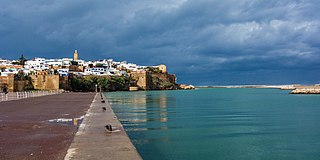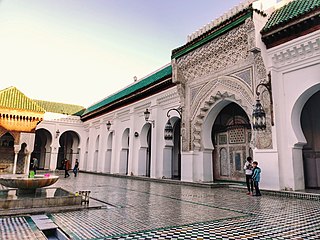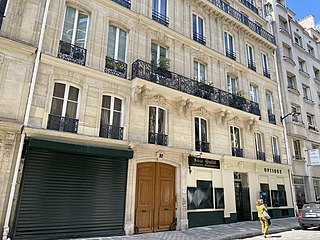Edmond Brion | |
|---|---|
 | |
| Occupation | Architect |
| Practice | Associated architectural firm[s] |
Edmond Brion (1885 Soissons - 1973) was a French architect active in Casablanca during the French Protectorate.
Edmond Brion | |
|---|---|
 | |
| Occupation | Architect |
| Practice | Associated architectural firm[s] |
Edmond Brion (1885 Soissons - 1973) was a French architect active in Casablanca during the French Protectorate.
After World War I and after having studying at the École des Beaux-Arts in Paris in the Paulin studio, Brion settled in Casablanca and worked with Auguste Cadet through the mid 1930s. While working with Cadet, Brion contributed to the project of the nouvelle ville indigène , now known as the Hubous, [1] and designed the Tasso Building (1931) as well as that of the Société commerciale des grains .
His two major works are the Bendahan Building (1935) located at November 16 Square in Derb Omar, and Casablanca's branch of the State Bank of Morocco (1937), featuring a large hall of marble, Art Deco metalwork, and exceptional reinterpreted zeliij. He also designed the cité ouvrière indigène (1939) for the Compagnie Sucriere Marocaine (COSUMA) and the colonial brothel quarter known as Bousbir.
In 1930, he founded the Moroccan chapter of SADG (Société des architectes diplômés par le gouvernement). [2]

Casablanca, also known in Arabic as Dar al-Bayda is the largest city in Morocco and the country's economic and business center. Located on the Atlantic coast of the Chaouia plain in the central-western part of Morocco, the city has a population of about 3.71 million in the urban area, and over 4.27 million in the Greater Casablanca, making it the most populous city in the Maghreb region, and the eighth-largest in the Arab world.

Rabat is the capital city of Morocco and the country's seventh largest city with an urban population of approximately 580,000 (2014) and a metropolitan population of over 1.2 million. It is also the capital city of the Rabat-Salé-Kénitra administrative region. Rabat is located on the Atlantic Ocean at the mouth of the river Bou Regreg, opposite Salé, the city's main commuter town.

Fes el Bali is the oldest walled part of Fez, Morocco. Fes el Bali was founded as the capital of the Idrisid dynasty between 789 and 808 AD. UNESCO listed Fes el Bali, along with Fes Jdid, as a World Heritage Site in 1981 under the name Medina of Fez. The World Heritage Site includes Fes el Bali's urban fabric and walls as well as a buffer zone outside of the walls that is intended to preserve the visual integrity of the location. Fes el Bali is, along with Fes Jdid and the French-created Ville Nouvelle or “New Town”, one of the three main districts in Fez.

The history of the city of Casablanca in Morocco has been one of many political and cultural changes. At different times it has been governed by Berber, Roman, Arab, Portuguese, Spanish, French, British, and Moroccan regimes. It has had an important position in the region as a port city, making it valuable to a series of conquerors during its early history.
Jean-François Zevaco was a French-Moroccan architect born in Casablanca. He is considered an emblematic figure of the modernist architectural movement in Morocco and in Africa, and his legacy is important in terms of the number of constructions built across Morocco, the diversity of his works, and their international aura.

The Hubous, or colloquially Habous, is one of the older neighborhoods of Casablanca, Morocco. Its development dates back to 1916, in the early stages of the French protectorate. The neighborhood is a cultural and religious center for Casablanca and for Morocco, as it hosts the Moroccan Ministry of Islamic Affairs as well as bookstores of important Moroccan and Arabic publishing houses. The many traditional and historic buildings also make the Hubous a popular tourist destination.
Michel Écochard was a French architect and urban planner. He played a large part in the urban planning of Casablanca from 1946 to 1952 during the French Protectorate, then in the French redevelopment of Damascus during its occupation of Syria. He was also trained as an archeologist.

Fez or Fes is a city in northern inland Morocco and the capital of the Fès-Meknès administrative region. It is the second largest city in Morocco, with a population of 1.11 million according to the 2014 census. Located to the north west of the Atlas Mountains, Fez is linked to several important cities of different regions; it is 206 km (128 mi) from Tangier to the northwest, 246 km (153 mi) from Casablanca, 189 km (117 mi) from Rabat to the west, and 387 km (240 mi) from Marrakesh to the southwest. It is surrounded by hills and the old city is centered around the Fez River flowing from west to east.

Albert Laprade was a French architect, perhaps best known for the Palais de la Porte Dorée. During a long career he undertook many urban renewal projects as well as major industrial and commercial works. A skilled artist, he published a series of sketch books of architecture in France and other Mediterranean countries.
The following is a timeline of the history of the city of Rabat, Morocco.

The R'cif Mosque is a Friday mosque in Fes el-Bali, the old city (medina) of Fez, Morocco. It has one of the tallest minarets in the city and overlooks Place R'cif in the heart of the medina.

United Nations Square is a public square in the center of Casablanca, Morocco. It has been central in the history of Casablanca.

Mohammed V Square is a public square of historical and symbolic significance located in central Casablanca, Morocco. It was established in 1916 at the beginning of the French protectorate in Morocco under Resident-general Hubert Lyautey, on a design by architects Henri Prost and Joseph Marrast.

Cherratine Madrasa is an Islamic school or madrasa that was built in 1670 by the Alaouite Sultan Moulay al-Rashid. It is located in the city of Fez in Morocco. The madrasa is also called Er-Rachidia Madrasa or Ras al-Cherratine Madrasa.
The Wilaya Building is the building that houses the administration of Grand Casablanca. It was designed by Marius Boyer and built from 1928-1937 during the French Protectorate in Morocco. The building is located at Muhammad V Square in central Casablanca, Morocco, and it remains an emblematic building of the city's architecture.

The architecture of Casablanca is diverse and historically significant. Casablanca, Morocco's economic capital, has a rich urban history and is home to many notable buildings in a variety of styles. Throughout the 20th century, architecture and urban development in Casablanca evolved in a way that was simultaneously specific to the city's contexts, and consonant with international ideas.

Dar Adiyel or Dar 'Adiyil is a historic mansion in Fes el-Bali, the old medina of Fes, Morocco. It is located in the Zqaq el-Bghal neighbourhood, a short distance south from Tala'a Seghira street.

The History of Fez begins with its foundation by Idris I and Idris II at the end of the 8th century and the beginning of the 9th century CE. It initially consisted of two autonomous and competing settlements on opposing shores of what is now known as the Oued Fes. Initially inhabited by a largely Berber (Amazigh) population, successive waves of mainly Arab immigrants from Ifriqiya (Tunisia) and al-Andalus (Spain/Portugal) over time gave the nascent city an Arab character as well. After the downfall of the Idrisid dynasty, it was contested between different Zenata groups allied with either the Fatimid Caliphate or the Umayyad Caliphate of Cordoba. In the 11th century the Almoravid sultan Yusuf ibn Tashfin conquered the region and united its two settlements into what is today the Fes el-Bali quarter. Under the rule of the Almoravids and of the Almohads after them, despite losing the status of capital to Marrakesh, the city remained the economic and political center of northern Morocco and gained a reputation for religious scholarship and mercantile activity.
Abdelouahed Mountassir is a Moroccan architect and urban planner. He is mainly known for his designs of the National Library of the Kingdom of Morocco (2008), for the future Ibn Sina University Hospital in Rabat and for urban development projects in Rabat and Casablanca.

The State Bank of Morocco was a quasi-central bank established in 1907 following the Algeciras Conference, to stabilize the Moroccan currency and serve as a vehicle for European and especially French influence in the Sultanate of Morocco. Following the independence of Morocco, it was replaced in 1959 by the newly created Banque du Maroc, known since 1987 as Bank Al-Maghrib.